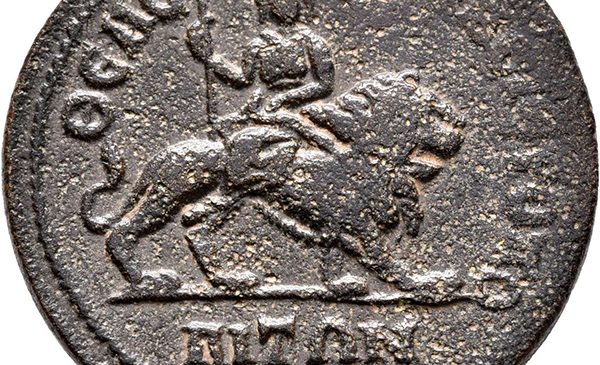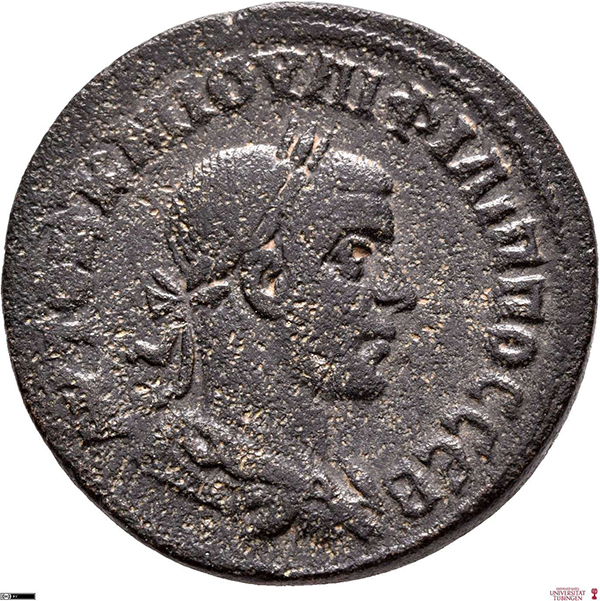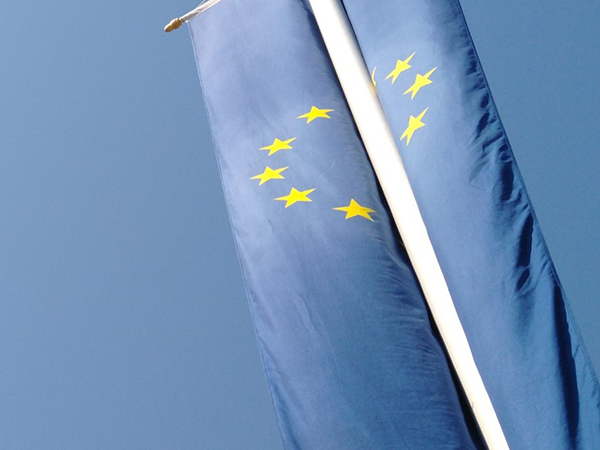By Mona Hähnle
There are cases where coins combine very well with literary sources and complement them visually. This is also the case with the coin presented here. It is a bronze coin with a weight of 17.23 g and a diameter of 3 cm. The portrait of the Roman Emperor Philip II is depicted on the obverse. He wears a laurel wreath, armour and a cape draped on his back. The inscription names the emperor in ancient Greek. On the reverse of the coin is the goddess Atargatis. She is seated frontally on a lion striding to the right. In her right hand she holds a sceptre and on her head she wears a mural crown. The ancient Greek transcription calls her the “Syrian goddess of Hierapolis”.
The main place of worship of Atargatis, who was worshipped as the mother of the gods, as the mistress of the sea and the animals, as an erotic and warlike deity and as a goddess of fate and protection, was the ancient city of Hierapolis, today’s Manbij in northern Syria, from which our coin also comes. Unfortunately, not much remains of the ancient city, except for some remains of the city wall, as it has been built over in a modern way. However, the 2nd century AD satirist Lucian of Samosata gives a detailed account of the temple and the cult of Atargatis. For imperial Syria, this source is unique and helps us gain a vivid insight into the cult practices of a region of which we have little archaeological evidence outside of coinage.

In his work, Lucian describes the appearance of the statue of Atargatis, which no longer exists today: “In this innermost part of the temple stands the statue […] seated on lions […] In one hand she holds a sceptre, in the other a spindle; on her head she wears a tower and is surrounded with rays; she is also adorned with the girdle […] Moreover, she is hung all over with sheets of gold, set with very precious white, water-blue and fire-coloured gems.” Comparing this description with the coin image, one can see that they agree with each other in many respects. The smaller attributes such as the spindle and girdle are not visible on the coin, as the coin image is too small to depict such details.
Through the work of Lucian we have the opportunity to compare the statue of Atargatis with the representation on the coin and learn more about the cult and temple of the goddess. Lucian describes this as the largest and most venerable temple in the whole world and reports of festivals for which pilgrims travelled from far and wide. The sanctuary of Atargatis was thus of supra-regional importance and also played a major role for the inhabitants of Hierapolis because it brought tourists, money and trade goods to the city. This is also reflected in the local coinage, since on almost all coins of Hierapolis the Syrian goddess is named and depicted in the circumscription as on our coin.
The text was written in the winter semester 2021/22 at the Institute for Classical Archaeology at the University of Tübingen in the seminar “On the Coast and in the Desert. The Coins of Ancient Syria” under the direction of Prof. Stefan Krmnicek. The course was dedicated to the extensive coinage of the ancient Syrian cities and their cultural, religious and political background. Selected results of the students’ seminar work will be presented in tünews INTERNATIONAL so that as many people as possible can share in the interesting findings.
tun22102501
Bronzemünze aus Hierapolis. Die Vorderseite zeigt das Portrait des Kaisers, die Rückseite zeigt das Kultbild der lokalen Gottheit Atargatis (https://www.ikmk.uni-tuebingen.de/object?lang=de&id=ID7879). Foto: Stefan Krmnicek.
001722
001723




